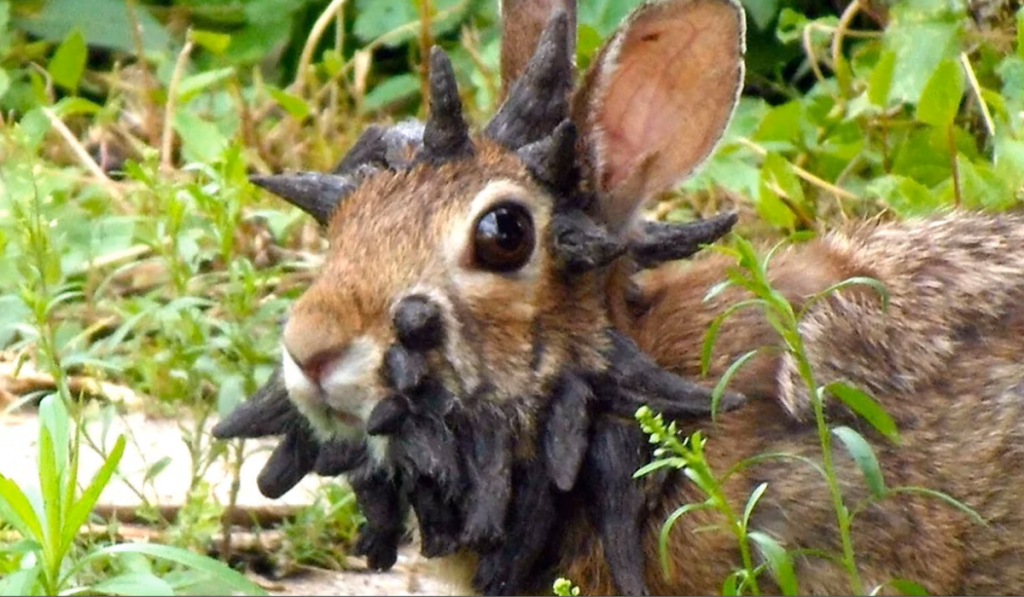you’re hiking through a Colorado meadow when you spot what appears to be a rabbit with horn-like growths protruding from its head. Your first thought might be that you’ve stumbled upon a real-life jackalope or witnessed something from a horror movie. In reality, you’ve likely encountered a cottontail rabbit infected with Shope papillomavirus (SPV), commonly known as the “American rabbit virus.”
These eerie-looking creatures, sometimes dubbed “zombie bunnies” or “Frankenstein rabbits,” have been capturing attention and sparking curiosity for decades. But what exactly is causing these bizarre transformations, and should we be concerned?

What Is Shope Papillomavirus?
Shope papillomavirus is a species-specific virus that affects wild cottontail rabbits across parts of the United States, particularly in the Midwest and mountain states like Colorado. Named after researcher Richard Shope who first documented it in the 1930s, this virus causes distinctive wart-like growths on infected rabbits’ faces and heads.
These growths can develop into dramatic horn-like or tentacle-shaped protrusions, creating an appearance so striking that they’ve become part of American folklore. In fact, many researchers believe that SPV-infected rabbits may have inspired the legendary jackalope—that mythical creature depicted as a rabbit with antelope horns that has become a staple of Western American culture.
How the Virus Spreads
The transmission of SPV occurs through two primary pathways:
Direct contact between infected and healthy rabbits allows the virus to spread within rabbit populations, particularly during mating season or territorial disputes.
Vector transmission happens through blood-feeding insects including fleas, ticks, and mosquitoes. These insects pick up the virus when feeding on infected rabbits and can then transmit it to healthy ones. This explains why SPV infections tend to spike during warmer months when insect populations are at their peak.
Impact on Infected Rabbits
Despite their alarming appearance, most rabbits with SPV can live relatively normal lives. The growths are typically benign and cause minimal discomfort unless they develop in problematic locations. However, complications can arise when:
- Growths appear near the eyes, potentially interfering with vision
- Horn-like protrusions develop around the mouth, making eating difficult
- The growths become large enough to impede movement or grooming
In some cases, particularly among domestic rabbits, these initially benign tumors can progress to malignant cancerous growths, making the condition more serious for pet rabbits than their wild counterparts.
The Rabbit’s Natural Defense
Remarkably, rabbits possess natural immune responses that can sometimes overcome the virus. In many cases, infected rabbits’ immune systems gradually combat the infection, causing the growths to shrink and eventually disappear entirely. This natural recovery process can take months or even years, but it demonstrates the resilience of these animals’ biological defenses.
Public Health and Safety Concerns
One of the most reassuring aspects of SPV is its species-specific nature. The virus poses absolutely no threat to humans, dogs, cats, or other animals. This means that:
- Pet owners don’t need to worry about their animals contracting the virus from wild rabbits
- Humans cannot become infected through contact with affected rabbits
- The virus presents no public health emergency
For wildlife enthusiasts and hikers who might encounter these unusual-looking rabbits, observation from a respectful distance is perfectly safe.
Treatment and Management
Currently, there is no cure for SPV in wild rabbit populations, and intervention in natural settings is generally not recommended or practical. For domestic rabbits that develop problematic growths, veterinary intervention may include:
- Surgical removal of growths that interfere with eating or vision
- Supportive care to maintain the rabbit’s overall health
- Monitoring for potential malignant transformation
Living with the Virus
The presence of SPV in American rabbit populations represents a fascinating example of how wildlife adapts to viral challenges. While the visual impact is dramatic, the virus has been circulating for nearly a century without causing population collapses or significant ecological disruption.
These “horned rabbits” serve as a reminder that nature often produces phenomena that seem straight out of science fiction. The next time you hear tales of jackalope sightings or stumble across photos of strange-looking rabbits online, you’ll know there’s real science behind the seemingly mythical creatures.
The Bigger Picture
Shope papillomavirus offers valuable insights into viral evolution, species-specific infections, and the complex relationships between wildlife, pathogens, and their environments. As climate change affects insect vector populations and rabbit habitats, researchers continue monitoring how these factors might influence SPV transmission patterns.
While these “zombie bunnies” might look like something from a nightmare, they’re actually a testament to the incredible diversity and adaptability of life on Earth. The American rabbit virus reminds us that sometimes the most extraordinary phenomena have been hiding in plain sight, waiting for curious minds to uncover their secrets.
Understanding SPV helps us appreciate both the complexity of wildlife disease dynamics and the importance of species-specific research in veterinary medicine. Most importantly, it shows us that even the most unusual natural phenomena usually have logical, scientific explanations even if they do look like something straight out of folklore.
